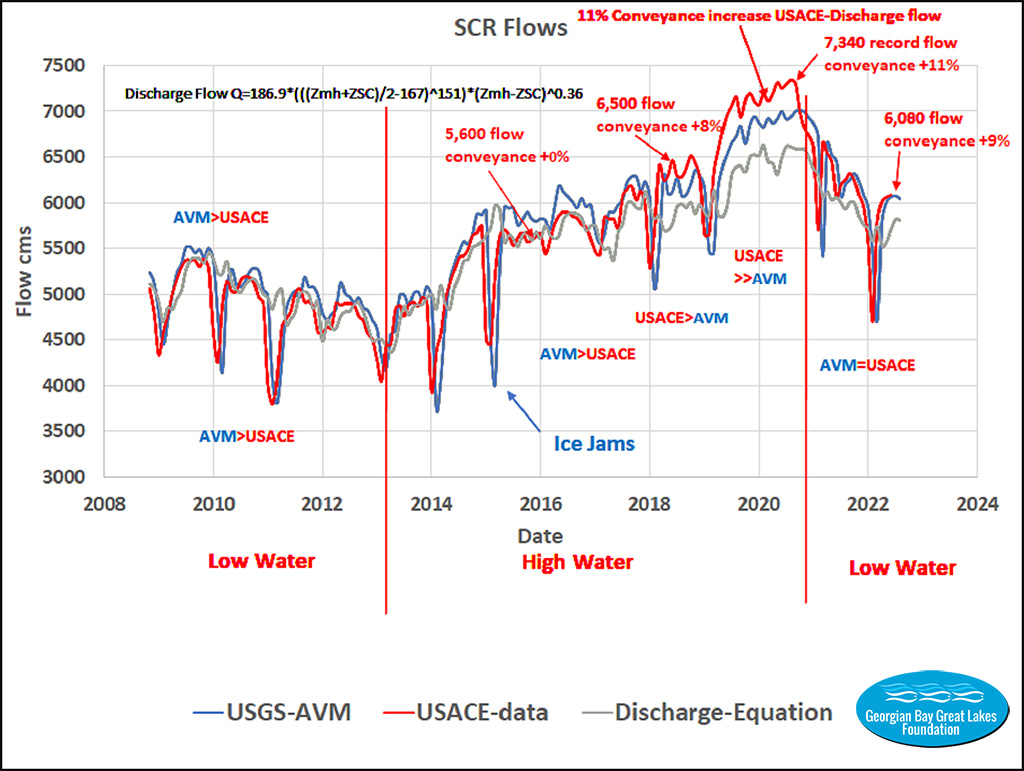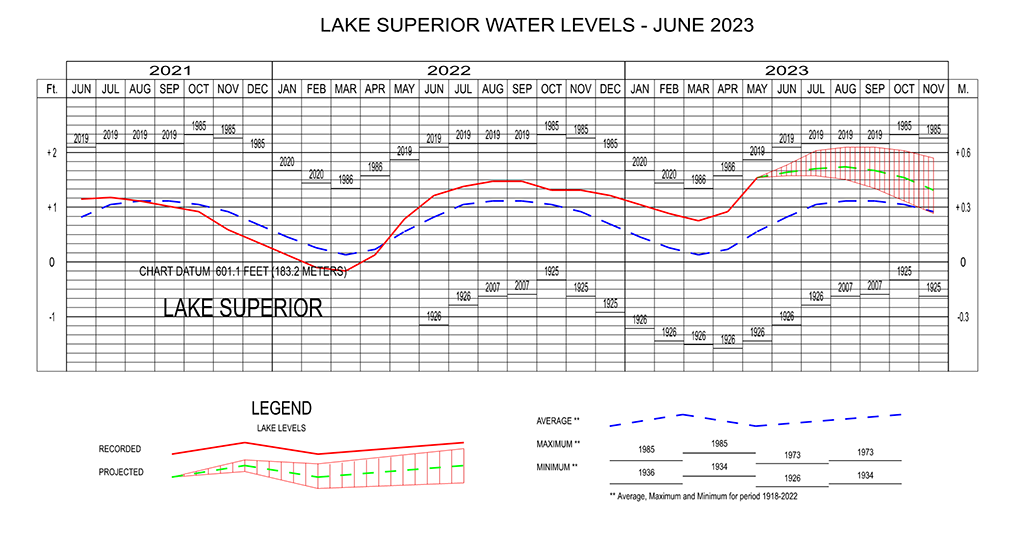Heads Up!!
July 2023 – GBGLF’s evidence shows the St. Clair River is eroding again – contributing to the sudden decline of our water levels!
Once again our hydraulic control engineer Bill Bialkowski has determined that the St. Clair Riverbed is eroding – increasing the outflow and contributing to the sudden decline of our water levels. Bill did similar assessment work in 2003 that led to Baird Report I and the IJC undertaking their Upper Lakes Study.
IJC’s Recommendations and Government’s Inaction
Despite how flawed that work was, the IJC Commissioners in 2013 provided some wise advice to our governments.
- The Commission recommends that the Governments undertake further investigation of structural options to restore water levels in Lake Michigan-Huron by 13 to 25 cm (about 5 to 10 in). The low end of the range addresses compensation for the early 1960s channelization and the higher end would offset the additional change in conveyance capacity that has been estimated by the Study Board to have occurred since then.
- The Commission encourages the Governments to focus on an option that would not result in a permanent restoration change that could exacerbate future high water levels, but rather one that could primarily provide relief during low water periods.
- Finally, the Commission recommends that the Governments undertake periodic bathymetric surveys along the full reach of the St. Clair River and its delta in order to better understand the conveyance issue in the St. Clair River.
However, our government has not acted on this decade-old advice.
GBGLF’s Funding Request and St. Clair River’s Condition
GBGLF has now requested funding from our Federal government – $1.5M to be able to retain once again the internationally respected coastal consulting engineering firm W.F. Baird & Associates. The aim is to collect current bathymetric data of the St. Clair River and accurately assess the conveyance change and then determine best methods to stop the erosion and best options to hold back water during low supply conditions (but not interfere with shipping or fish movement).
Impact of Ice Jams and Increased Outflow
Since about 2012, we have been observing the ice jams that happen most winters in the St. Clair River due to ice breakers opening the channel for shipping (the Seaway is supposed to be closed in the winter but not the St Clair and Detroit Rivers – it is as if no one cares about the impacts of this activity). And since about 2013 we have been watching the US Geological Survey’s posted St. Clair River flows that should only fluctuate based on levels and weather events. But take a look at Bill’s graph below;
The steep drops show the frequent winter ice jams that are very likely eroding the exposed soft sands and clays continually, deepening the river and increasing the outflow. Bill has calculated that there appears to be an additional 9% increase in outflow of this very large river, over and above the 10% that the Baird Report had claimed in 2005. This is a very significant increase. NO GOVERNMENT AGENCY appears to even be aware of this!
Climate Change Impacts and Flawed Predictions
To make things worse ECCC has released their climate change impacts on the Great Lakes but they did not include St Clair River conveyance change in their work. This omission indicates that their predictions for our lake levels are flawed.
Future Predictions and Current Reality
The bottom line based on ECCC’s predictions and our own Baird Report III is that our water levels are going down from where they are now until 2030, and could be as much as 3 feet below the recent 2013 record low. That is something that every single soul that cares about our precious Bay needs to sit up and pay attention to – i.e., what could be done.
Background Information and IJC’s Decisions
- The International Lake Superior Board of Control (ILSBC) has been holding back significant amounts of water while the Canadian hydrogenator undergoes repairs. And the Board has just announced that the IJC Commissioners have agreed to allow the Board to continue to deviate from their Regulation Plan 2012 for 11 months with a total reduction in flows of 150 CuM/sec over eleven month resulting in lowering our levels in addition to the impact of much higher reductions in discharges over the past winter months. These reductions in discharges do not respect the IJC’s own mandate to “balance interests both upstream and downstream.”
- Add to that the fact that the St. Clair River flows are about 18% higher than they should be based on the last released discharge equation at current water levels. The increase in the conveyance capacity (calculated by our hydraulic control engineer Bill Bialkowski) of the river will further lower water levels during the next low water level period. No government agency is even looking at the impact of two recent major ice jams in the St. Clair River on the conveyance capacity of the river due to erosion of the exposed sand and clay sediments.
- What is the impact of the IJC’s decisions to ignore Lakes Michigan Huron and Georgian Bay? You can see in the graphs below placed side by side at the same scale (not vertically with different scales as ECCC and USACE post them) so you cannot see the direct comparisons. Our water levels have come down significantly over the past two years but as we approach further declines as predicted you can see that Lake Superior levels are going up. All in an effort to keep Lake Superior within a 4 foot range while our range is slowly getting wider – now to a range of about 6.5 feet.
And note this posting on the ILSBC June news;
- At the beginning of June, the lake-wide average water level of Lake Superior is 26 cm (10.2 in) above the seasonal long-term average (1918-2022) and 14 cm (5.5 in) above the level of a year ago.
- At the beginning of June, the lake-wide average water level of Lake Michigan-Huron is 15 cm (5.9 in) above average and 11 cm (4.3 in) below the level of a year ago.
So just how does the IJC’s ILSBC justify holding back water on Lake Superior given the disparity between the lakes?
Misleading Predictions and the Need for Immediate Action
The latest issue of GBA UPDATE presented a questionable graph, presumably based on ECCC data, predicting a significant rise in water levels by 2050 and 2080. However, these projections fail to consider changes in St. Clair River conveyance and the natural cycles of the Great Lakes, relying solely on global climate change models. The further we project into the future, the greater the uncertainty and the less reliable the predictions become.
So, why focus on the uncertain forecasts for 2050 and 2080 when we face immediate concerns? By 2030, we could be facing a scenario where islands become accessible by foot, town docks, navigation channels, and marinas are threatened, and vast wetlands dry up, leading to a significant loss of habitat (as per Prof Pat Chow-Fraser from McMaster University).
Instead of fixating on distant future scenarios, we should be addressing the present and near future. We need to discuss what can be done now to mitigate the extreme low levels in the short term and the potential high levels in the longer term. Ignoring the immediate impacts and focusing on distant uncertainties is akin to burying our heads in the sand.

Conclusion and Call to Action
Georgian Bay’s unique geography makes its shorelines particularly vulnerable to extreme water level changes, more so than any other part of the Great Lakes. Despite this, our Federal government has largely overlooked Georgian Bay. While low water levels might be preferred by some for the larger beaches they provide, the broader implications are far more serious.
If we desire action to mitigate these extreme water levels, we must be prepared to voice our concerns loudly and persistently until our government takes notice. If Georgian Bay were in the U.S., it would likely have been recognized as a national coastal ecological reserve long ago, and the IJC’s 2013 advice to governments would have been implemented.
Our organization is now requesting $1.5M from our Federal government to engage the services of W.F. Baird & Associates. This internationally respected firm would collect depth profiles of the St. Clair River and assess conveyance change capacity. With this data, they could identify the most effective strategies to maintain water levels in the middle Great Lakes.
W.F. Baird & Associates, based in Oakville, ON, has a proven track record, including contracts with U.S. agencies to redesign the Mississippi delta to prevent flooding in New Orleans. They are well-equipped to lead this research for the St. Clair River, as Canada lacks a government agency capable of conducting this type of complex hydraulic control engineering and Great Lakes flow assessment.
However, this crucial work will not proceed unless you, the public, demand action now and support the $1.5M funding for GBGLF to undertake this critical research. Without this, we risk sitting back and watching the water levels continue to decline, with enormous economic and ecological impacts.
We are striving to reach senior politicians with our concerns about water levels, but we need your support. The recent 9% increase in the St. Clair River’s conveyance capacity spells disaster for Georgian Bay, both environmentally and economically.
Science Reporting Seminar 2023
Did you miss our May 13, 2023 Science Reporting sessions? If so the presentations are all posted on our website HERE.
Thanks for your support!
Mary Muter, Chair, Georgian Bay Great Lakes Foundation
We need your support so we can continue this work. Here’s how to donate
MAKE YOUR IMPACT TODAY
Donations help us make a difference
because we can continue our work and bring it to a conclusion for future generations. We depend on private donors, foundations and sponsors like you.
Charitable donations can help reduce, or even cancel out, the tax
you would otherwise have to pay to the government.
PREFER TO DONATE BY MAIL? HERE'S HOW...
Please make out your cheque to
Huronia Community Foundation
and mark in the notation line
“for Georgian Bay Great Lakes Foundation”
and mail it to:
Huronia Community Foundation,
P.O. Box 324, Midland, Ontario, L4R 4L1
SHARE DONATIONS ARE NOW EASIER
Donate Securities to the Georgian Bay Great Lakes Foundation Fund
through the Huronia Community Foundation
To ensure that we credit the right fund, ask that donations be directed to:
Georgian Bay Great Lakes Foundation Fund
Georgian Bay Great Lakes Foundation is a Federally registered charity
(Charitable number: 74856 7096 RR0001)
affiliated with the federally-registered charity, Huronia Community Foundation
You can get more information about claiming donations from the CRA website and your Financial Advisor.





